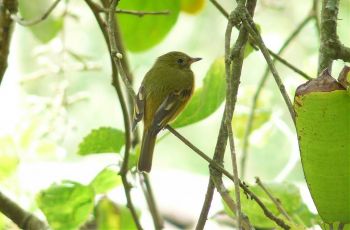
Photo by Stanley Jones
Canopy Lodge, El Valle de Antón, Coclé Province, Panama, December 2017
- Mionectes oleagineus
Identification
13 cm (5 in)
- Olive-green upperparts
- Green head and upper breast
- Ochre underparts
- Two buff wing bars, wing feathers edged with buff
The male is slightly larger than the female, but otherwise similar.
Variations
The subspecies differ in the distinctness of the wing bars or the shade of the upperparts.
Distribution
Southern Mexico, Central America, Trinidad and Tobago, and in South America in Colombia, Ecuador, Peru, Bolivia, Brazil, Venezuela and the Guianas.
Taxonomy
This species was previously placed in the genus Pipromorpha.
Subspecies
There are 7 subspecies[1]:
- M. o. assimilis :
- Tropical southern Mexico to eastern Costa Rica and western Panama
- M. o. parcus:
- M. o. pacificus:
- M. o. abdominalis:
- Tropical northern Venezuela (Distrito Federal and Miranda)
- M. o. pallidiventris:
- M. o. dorsalis:
- Tepuis of south-eastern Venezuela (Gran Sabana of Bolívar)
- M. o. oleagineus:
Habitat
Humid forests, usually in undergrowth near water. Absent at high elevation.
Behaviour
Breeding
They construct a moss-covered ball nest with a side entrance, suspended from a root or branch. It is often placed over water. The clutch consists of 2-3 white eggs which are incubated by the female for 18-20 days. The male takes no part in rearing the young.
Diet
Their diet consists mostly of fruit, particularly mistletoe berries. They also eat some insects and arthropods.
References
- Clements, J. F., T. S. Schulenberg, M. J. Iliff, D. Roberson, T. A. Fredericks, B. L. Sullivan, and C. L. Wood. 2017. The eBird/Clements checklist of birds of the world: v2017, with updates to August 2017. Downloaded from http://www.birds.cornell.edu/clementschecklist/download/
- Handbook of the Birds of the World Alive (retrieved Jan 2018)
- Wikipedia
Recommended Citation
- BirdForum Opus contributors. (2025) Ochre-bellied Flycatcher. In: BirdForum, the forum for wild birds and birding. Retrieved 10 May 2025 from https://www.birdforum.net/opus/Ochre-bellied_Flycatcher




